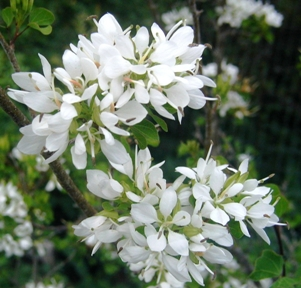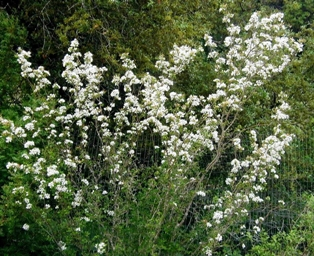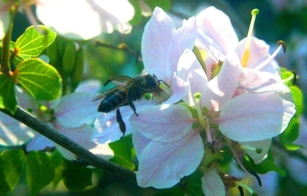Anacacho orchid tree (Bauhinia lunarioides) is the Operation NICE! (Natives Instead of the Common Exotics!) choice for May. This large shrub or small tree is ever-increasingly popular as a hardy landscape plant for Hill Country yards.

Bauhinia is a large genus with 250 species of shrubs, trees, and vines growing in many warm parts of the world. The large-flowered orchid trees native to India and China are familiar to many people because they are cultivated along the Gulf Coast from Texas to Florida. They also are a favorite ornamental in California, Mexico, the Caribbean, both sides of the Mediterranean, and many other places.
The United States has only one native species of Bauhinia, the Anacacho orchid tree. This species grows only in three Texas counties and northeastern Mexico. For a while, it was thought to occur in Texas only in Kinney County in the Upper Cretaceous limestone hills called the “Anacacho Mountains.” Later it was found in Maverick County, probably in similar limestone terrain, and also in Val Verde County on the Lower Cretaceous limestone slopes of the Devils River valley.

The Anacacho orchid tree is a perfect NICE! plant, because it is drought-tolerant, needs little care and water, grows fairly fast, and produces abundant spring blooms. Even in the severe drought we’ve recently suffered, our Anacacho orchid trees are now thick with blooms.
The blooms are in tight clusters of white or pale-pink 3/4-inch flowers. The old species name B. congesta refers to the crowded flowers. Typical of most bauhinia, the leaves are distinctly bi-lobed. In Anacacho orchid trees the small leaves are divided to the base into two leaflets, giving a cloven-hoof shape. One of the common names, “pata de vaca” (cow hoof), is derived from the appearance of the leaves.
Anacacho orchid trees apparently can grow well in understory or open-sun sites. Both our Texas white orchid tree and our Northeastern Mexico pink orchid tree do very well in full sun. The population growing in the Dolan Falls area of the Devils River valley is in full sun.

The native stands of Anacacho orchid trees thrive in thin limestone soils, which would seem to bid well for their success in Hill Country gardens. Probably one of the most important requirements is good drainage. In this area, Anacacho orchid trees seem to be cold tolerant, but they may not easily survive the winters much farther north.
According to Robert Vines (Trees, Shrubs, and Woody Vines of the Southwest), the genus name Bauhinia is in honor of Caspar and John Bauhin, “Sixteenth-Century herbalists, an allusion suggested by the twin lobes of the leaves.” These Swiss brothers, however, were not twins. The younger brother Caspar (Gaspard) gained recognition as one of the earliest botanists to attempt a classification system based on common characteristics. In 1623 he published a description of over 6,000 plants in “Pinax theatric botanici.” Even though Bauhin did not conceive of a binomial nomenclature as used in Carl Linnaeus’ 1735 “Systema Naturae,” many names of genera he coined were adopted by Linnaeus and remain in use today.
